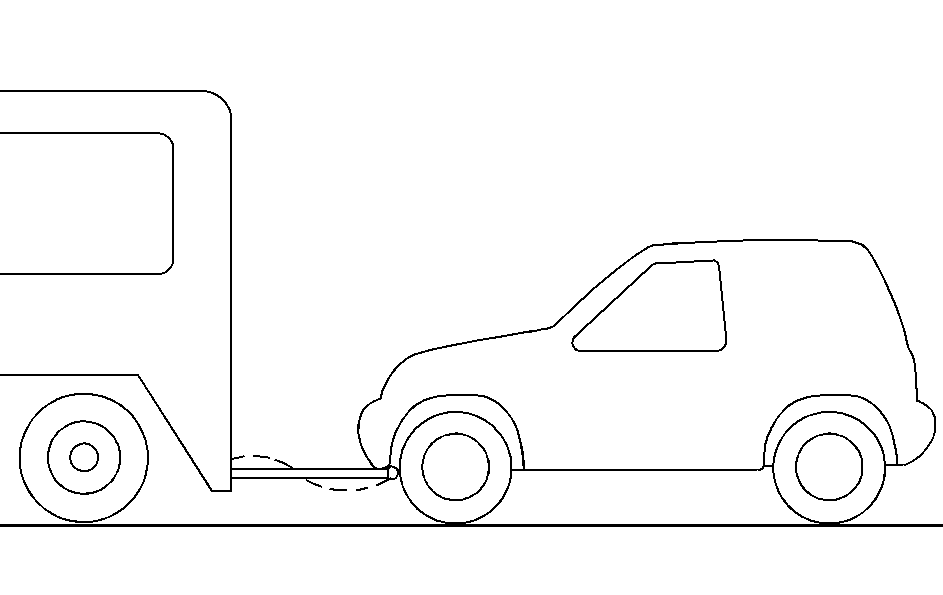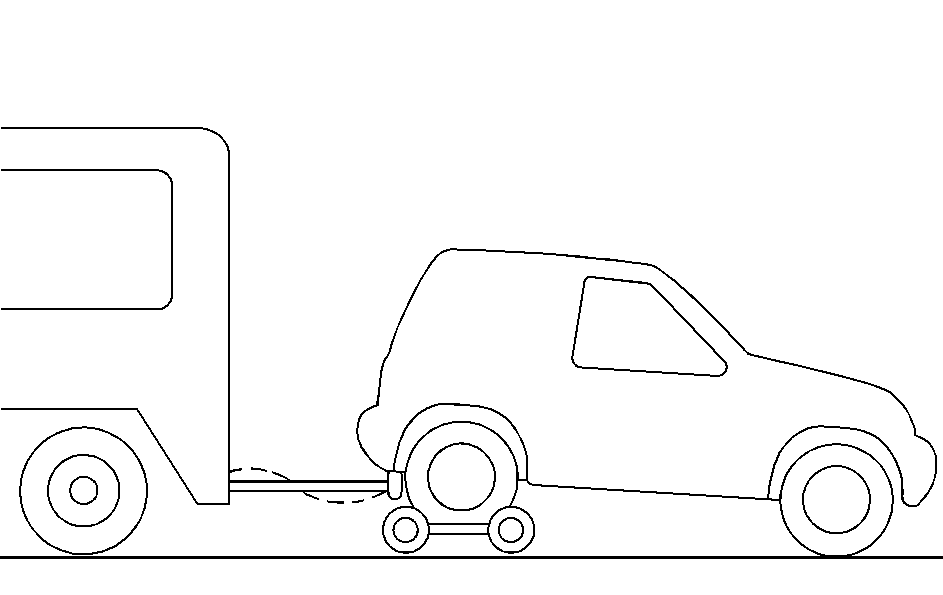Recreational vehicle towing means towing your vehicle behind another vehicle -- such as behind a motorhome. The two most common types of recreational vehicle towing are known as "dinghy towing" (towing your vehicle with all four wheels on the ground) and "dolly towing" (towing your vehicle with two wheels on the ground and two wheels up on a device known as a "dolly").
With the proper preparation and equipment, many vehicles can be towed in these ways. See "Dinghy Towing" and "Dolly Towing," following.
Here are some important things to consider before you do recreational vehicle towing:
| • | What's the towing capacity of the towing vehicle? Be sure you read the tow vehicle manufacturer's recommendations. |
| • | How far will you tow? Some vehicles have restrictions on how far and how long they can tow. |
| • | Do you have the proper towing equipment? See your dealer or trailering professional for additional advice and equipment recommendations. |
| • | Is your vehicle ready to be towed? Just as you would prepare your vehicle for a long trip, you'll want to make sure your vehicle is prepared to be towed. See Before Leaving on a Long Trip . |
Dinghy Towing
To tow your vehicle from the front (four-wheel-drive only), do the following:

Notice: If a two-wheel-drive vehicle is towed with all four wheels on the ground, the transmission could be damaged. The repairs would not be covered by the vehicle warranty. Do not tow a two-wheel-drive vehicle with all four wheels on the ground.
Follow these steps:
- Set the parking brake.
- Shift your automatic transmission into PARK (P), or your manual transmission to SECOND (2).
- With the ignition key in the ON position, move the transfer case to NEUTRAL and make sure the 4WD light on the instrument panel cluster is off. See Four-Wheel Drive .
- Turn the ignition key to ACC.
- Release the parking brake.
Notice: If you do not put the transfer case in NEUTRAL before towing a four-wheel-drive vehicle from the front, the vehicle could be damaged. The repairs would not be covered by your warranty. Always put the transfer case in NEUTRAL before towing your vehicle.
Stop towing every 200 miles (300 km) and start the engine. Leave the transfer case shift lever in NEUTRAL. Shift your automatic transmission to DRIVE (D); leave a manual transmission in SECOND (2) with the clutch engaged. Run the engine at 2,000 rpm for one minute to circulate oil in the transfer case. Turn the ignition key to ACC. Now, you can continue towing your vehicle.
Notice: Locking the steering column when towing your vehicle may damage the steering column. Always unlock the steering column before towing.
Notice: If you exceed 55 mph (90 km/h) while towing your vehicle, it could be damaged. Never exceed 55 mph (90 km/h) while towing your vehicle.
Caution: Shifting a four-wheel-drive vehicle's transfer case into NEUTRAL can cause your vehicle to roll even if the transmission is in PARK (P) for an automatic transmission, or if your vehicle is in gear, for a manual transmission. You or others could be injured. Make sure the parking brake is firmly set before you shift the transfer case to NEUTRAL.
Dolly Towing
To tow your vehicle from the rear, do the following:

The best way to tow your vehicle is from the rear. Follow these steps:
- Put the rear wheels on a dolly.
- If your vehicle is a four-wheel-drive vehicle, turn the ignition key to ON, move the transfer case lever into NEUTRAL and make sure the 4WD light on the instrument panel cluster is turned off. See Four-Wheel Drive .
- Turn the ignition key to ACC.
- Make sure the front wheels are facing straight forward and secure the steering wheel with a steering wheel clamping device designed for towing.
Notice: If a two-wheel-drive vehicle is towed with the rear wheels on the ground, the transmission could be damaged. The repairs would not be covered by the vehicle warranty. Never tow the vehicle with the rear wheels on the ground.
Notice: If you exceed 55 mph (90 km/h) while towing your vehicle, it could be damaged. Never exceed 55 mph (90 km/h) while towing your vehicle.
Caution: Shifting a four-wheel-drive vehicle's transfer case into NEUTRAL can cause your vehicle to roll even if the transmission is in PARK (P) for an automatic transmission, or if your vehicle is in gear, for a manual transmission. You or others could be injured. Make sure the parking brake is firmly set before you shift the transfer case to NEUTRAL.
